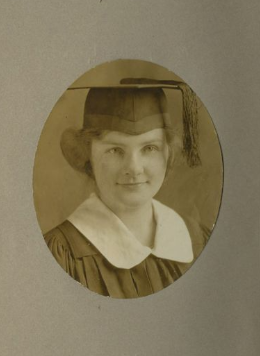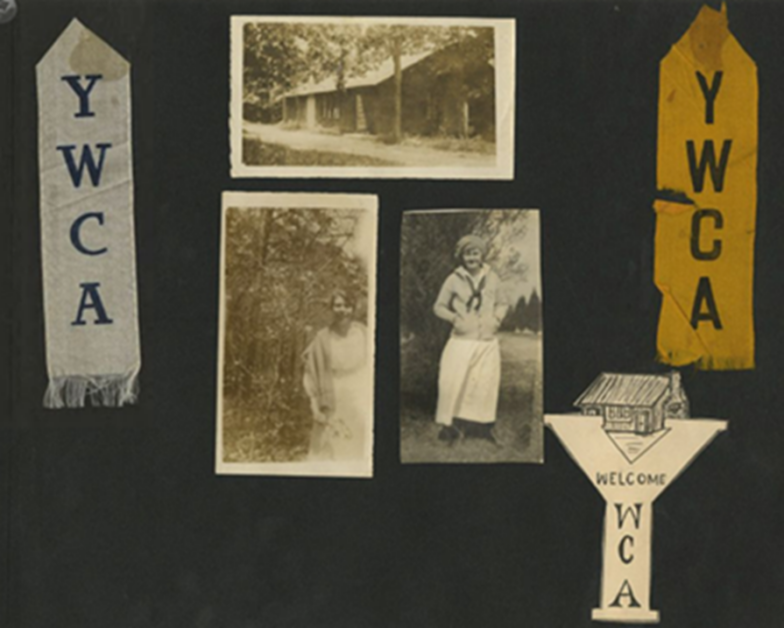by Kathelene McCarty Smith
Mary Sue Beam was a student at the North Carolina College for Women (now UNC Greensboro) between 1919 to 1923. These were important years in the history of the campus and the country. When Mary Sue left her home in Shelby, North Carolina, to attend the small women’s college in the fall of 1919, she stepped into an exciting new era of the school. The “Great War” had just ended the year before and by August of 1920, the 19th Amendment would be passed, giving women the right to vote. Indeed, her scrapbooks include a list of forty-two elections for which she planned to vote in absentia. Mary Sue viewed her college years through the lens of the “Roaring Twenties,” when the postwar economy was booming, and the school began a building campaign to meet the needs of a growing student body.

Memories of her time at the North Carolina College for Women (NCCW) were carefully curated in two scrapbooks; “Commencement Days,” and “My Memory Book: North Carolina College.” The latter was a gift from her friend Lois McMurry. These were typical of the prefabricated scrapbooks that became popular in the 1920s, which included illustrations and specifically labeled spaces for the name of the student and their friends, as well as many blank pages to hold photographs, correspondence, cards, and ephemera. As a freshman of the Class of 1923, Mary Sue proudly included her Class motto, “Courage,” the Class song, and the Class’s unique colors of red and white. She noted that these designations differed from the school’s motto, “Service,” the school song, and its corresponding colors of yellow and white.

Mary Sue’s college life poured onto the pages of her scrapbooks, which she lined with notes and candid photographs of friends and classmates, campus buildings, and trips to the Blue Ridge Mountains and Washington D.C. She was very active in many aspects of student life, taking on leadership roles as president of her class and as a member of the House of Representatives. Mary Sue’s scholarly efforts were acknowledged by her membership in the Tau Pi Delta Honor Society and her election as a Marshal. The Marshals was a service organization recognizing a student’s academic excellence and service record. Literary societies elected at least three Marshals annually from each class to serve on a Student Council, which acted as an advisory group to the college administration.

She was also involved in many school clubs, such as the Young Women Christian Association (YWCA), for which she served as a cabinet member. She also participated in the International Relations Club, the Inter-Society Extension Bureau, and the Red Cross. It may have been her work with the Extension Bureau that led to the inclusion of an intriguing, but unlabeled, photograph of a truck-pulled float representing the Department of Vocational Education farming initiatives.

There are many references to her membership in the Dikean Literary Society. Literary Societies were first established on campus in 1893, a year after the school opened. These groups were the primary social organizations on campus, hosting plays, debates, teas, and dances. At first, there were only two societies on campus, the Adelphian and the Cornelian, but as NCCW grew, the Dikean Society was added. The group was formed in 1919 with members from the other two societies, but in 1919, they began inducting new members. The Society’s colors were green and gold, adding even more colors to Mary Sue’s scrapbooks.
Along with other NCCW students, Mary Sue joined the Forest Avenue Baptist Church in Greensboro, and was in attendance when their “college hut” was dedicated in 1923. She must have been fairly active in the church, as she was asked to speak at the event, publicly answering the request of Mrs. C. A. Williams, the director of student activities of the College, who urged the students to use the hut “to serve the state and the world.” In April of the same year, Mary Sue attended the Southern Baptist Student Conference held in Greensboro, which featured musical performances and talks by speakers from throughout the Southeastern United States.

In addition to her club memberships and church activities, Mary Sue lead an active social life. The scrapbooks are a treasure trove of letters, notes, cards, and invitations from friends and sweethearts. Especially significant is a note granting Mary Sue permission to ride in cars with boys, a consent that was not readily given to students. Apparently, she spent time with several young men, including one named Jimmie, who declared that she was his ideal girl and that he “loved her more than he should.” She doesn’t mention if any of her admirers accompanied her to her sister’s wedding, during which she served as maid of honor. A related article about the wedding included in the scrapbooks, described Mary Sue as “charmingly gowned in champagne lace over turquoise blue,” and carrying yellow chrysanthemums.

In June of 1923, Mary Sue graduated from NCCW, participating in many campus events in honor of the senior class. She included sentimental notes and congratulatory ephemera in her scrapbooks, as well as a photograph of her graduation class parading down College Avenue holding a banner with their motto, “Courage.”

In June of 1923, Mary Sue’s thoughts were not only on the fun and frivolity of graduation parties. She was also concerned with finding employment. Her scrapbook contains letters from several North Carolina school districts regarding teaching positions available the following fall, although hints of where she eventually landed were not included. Further research reveals that Mary Sue did become a high school teacher in North Carolina, spending much of her career in Raleigh. She also became an author, writing articles about education and teaching. Mary Sue married Newton G. Fonville, ten years her senior, in January of 1928, and seems to have lived a full life, finally passing away in 1993, at the age of 92.
Link to the digitized scrapbooks: https://gateway.uncg.edu/islandora/object/mss%3AMSS0313
